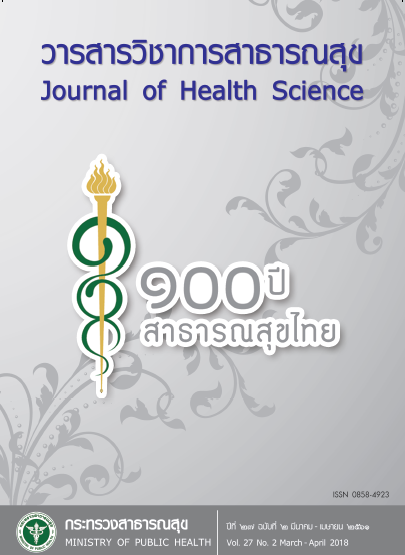Active Surveillance of Diseases and Health Hazard among Thai pilgrims Returning from Hajj, 2013
Keywords:
active surveillance, Hajj, MERS-CoVAbstract
This study focused on the active surveillance development among Thai Muslim returned from Hajj for early detected communicable disease and health hazard. We conducted a cross-sectional descriptive study to establish the surveillance: set meeting to stakeholders, verified, analyzed and reported this data every week after 1 month returned. A case definition was Thai Muslim developed at least one symptom as follow: fever, cough, rhinorrhea, sore throat, sputum, myalgia, dyspnea, chest discomfort, diarrhea or nausea between 21 October and 17 November 2013. There were 10,400 pilgrimages from 49 provinces of Thailand, 86.3% in the Southern regional. The ratio of male and female was 1:1.2. The main departure airlines were Emirates airline (29.1%), Thai Airways International airline (22.1%) and Egypt Air (17.0%), respectively. Most airport departures were at Suvarnabhumi Airport (62.0%), Hat Yai Airport (17.7%) and Phuket Airport (15.8%). The most of Pilgrims returned from Hajj in the first week (44.1%) and the second weeks (47.1%). Their average travelling time was 43.6±10.5 days. There were 9,023 reported after their return (86.8%), 216 persons (2.4%) had respiratory illness; and no case report of Middle East respiratory syndrome coronavirus (MERS-CoV). This surveillance process could detect communicable diseases as early as second week after the return; and the assignment of coordinators made the high coverage and timeliness of the case reports. Thus, this surveillance process should be integrated into the national diseases surveillance program in order to enhance the efficiency of the system.
Downloads
Downloads
Published
How to Cite
Issue
Section
License
Copyright (c) 2018 Journal of Health Science- วารสารวิชาการสาธารณสุข

This work is licensed under a Creative Commons Attribution-NonCommercial-NoDerivatives 4.0 International License.







